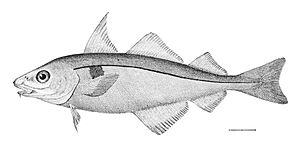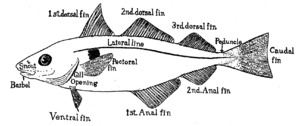Haddock facts for kids
The haddock (Melanogrammus aeglefinus) is a type of saltwater fish. You can find it in the northern parts of the Atlantic Ocean and the seas connected to it.
It's easy to spot a haddock! It has a black line running along its white side. This is called a lateral line. Also, it has a dark spot above its pectoral fin. People often call this spot a "thumbprint" or even "St. Peter's mark."
Haddock usually live in waters that are about 40 to 133 meters (130 to 436 feet) deep. But they can go as deep as 300 meters (984 feet)! They like water temperatures between 2 and 10 degrees Celsius (36 to 50 degrees Fahrenheit). Younger haddock prefer shallower waters, while older ones like deeper areas. Adult haddock don't travel long distances much, but younger fish might move around more. Haddock mostly eat small invertebrates, like tiny crabs or worms. Bigger haddock might sometimes eat other fish.
Haddock are typically between 38 and 69 centimeters (15 to 27 inches) long. They usually weigh between 0.9 and 1.8 kilograms (2 to 4 pounds). In recent years, haddock have been growing faster. This means they reach their adult size much earlier than before.
Life Cycle and Reproduction
Haddock lay their eggs between January and June. The busiest time for this is in late March and early April. Important places for haddock to lay eggs are near central Norway, southwest Iceland, and Georges Bank. An average female haddock can produce about 850,000 eggs. Larger females can lay up to 3 million eggs each year!
Haddock Fishing
Haddock can grow up to 1.1 meters (43 inches) long. People fish for haddock all year round. Some common ways to catch them include using Danish seine nets, trawlers, and long lines. In North America, the number of haddock caught for sale went down a lot in the past. But now, the population is getting better and recovering well.
Haddock as Food
Haddock is a very popular fish to eat! You can buy it fresh, smoked, frozen, or dried. Sometimes, it's even sold in cans. In Britain, haddock is one of the most popular fish used for the famous dish, fish and chips. It's often served alongside Atlantic cod and plaice.
Fresh haddock has white flesh. You can cook it in many of the same ways you would cook cod. To tell if a haddock fillet is fresh, check if it feels firm. Fresh fillets also look a bit see-through. Older fillets will look more chalky or opaque. In places like Boston, young, fresh haddock and cod fillets are often called "scrod."
Unlike cod, haddock doesn't get preserved well by salting. Instead, it's often preserved by drying and smoking.
Smoking haddock is a special skill, especially in Grimsby, England. Traditional Grimsby smoked fish are made in old smokehouses. These are often family businesses that have passed down their smoking skills for many generations. The haddock used in Grimsby usually comes from places like Iceland, Norway, and the Faroe Islands. These fishing areas are managed carefully to make sure there are enough fish for the future.
One famous type of smoked haddock is called Finnan haddie. It gets its name from the Scottish village of Finnan. There, it was traditionally cold-smoked over peat fires. Finnan haddie is often served poached in milk for breakfast.
Another special smoked haddock is the Arbroath smokie. This comes from the town of Arbroath on the east coast of Scotland. It's a hot-smoked haddock, which means it's already cooked and ready to eat!
Smoked haddock is naturally an off-white color. But often, it's dyed yellow, just like some other smoked fish. Smoked haddock is a key ingredient in the Anglo-Indian dish kedgeree. It's also used in the Scottish soup called "Cullen skink", which is a bit like a chowder.
Images for kids
See also
 In Spanish: Eglefino para niños
In Spanish: Eglefino para niños






